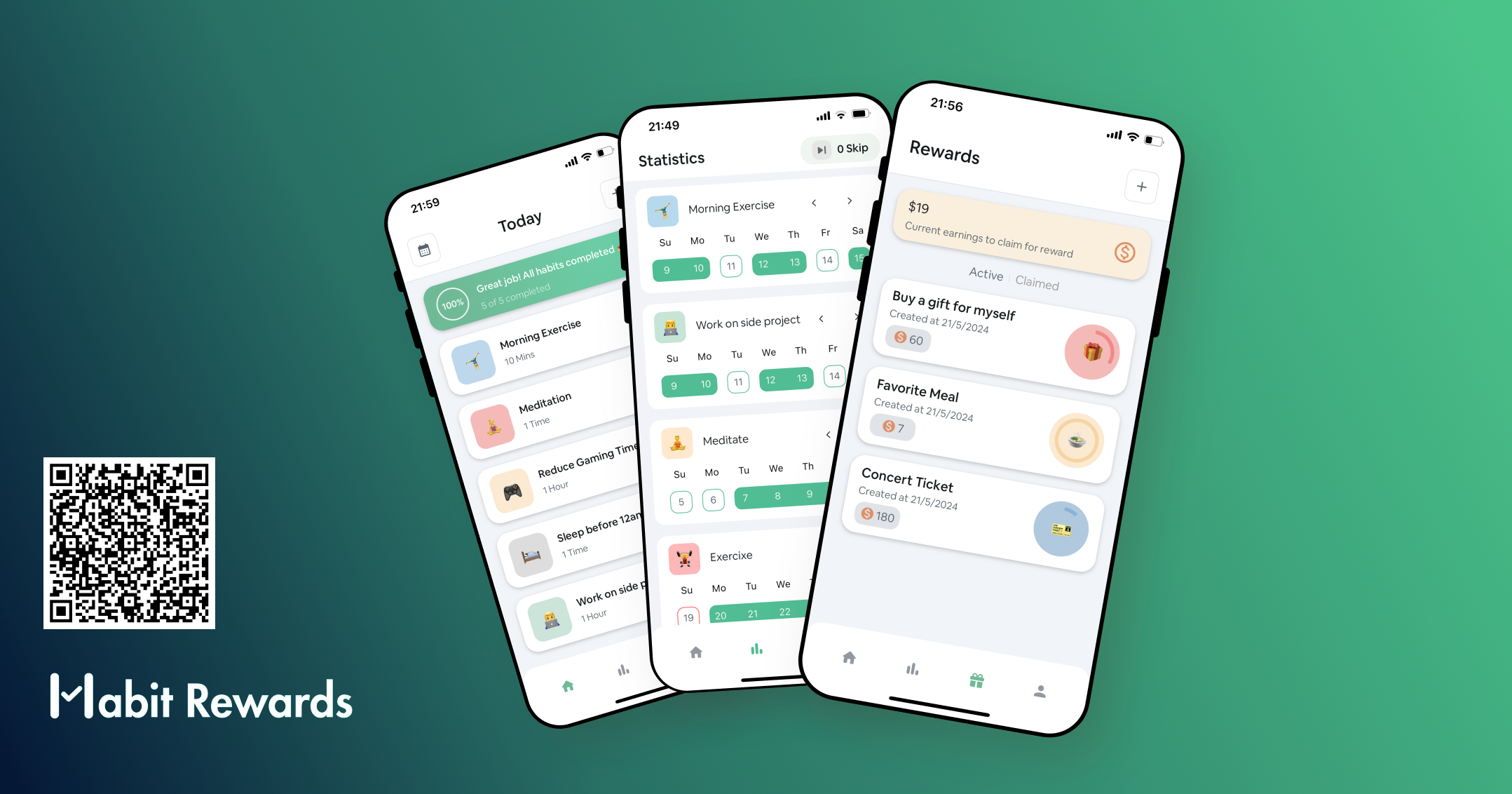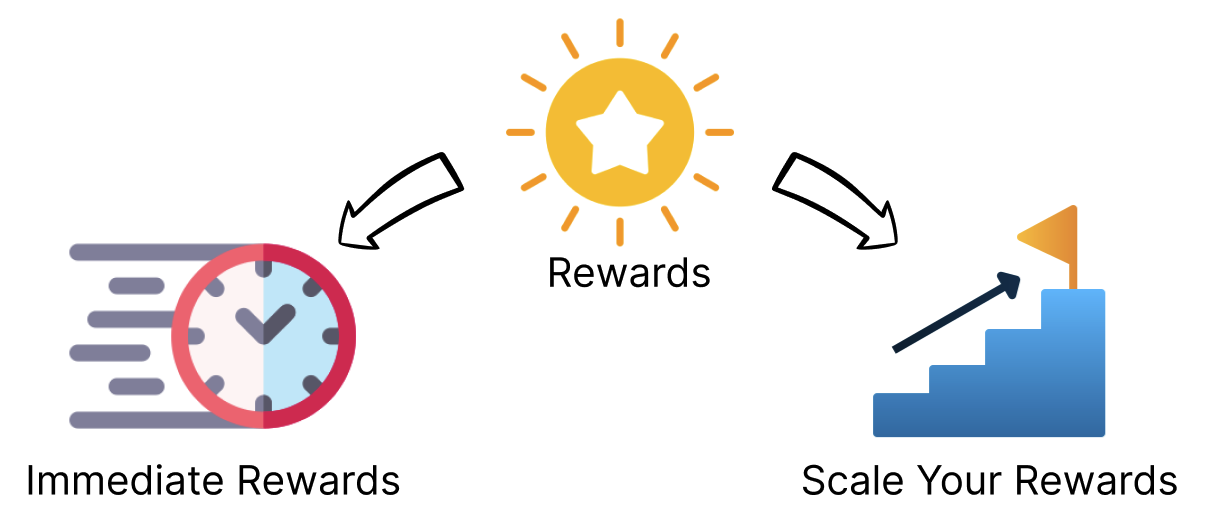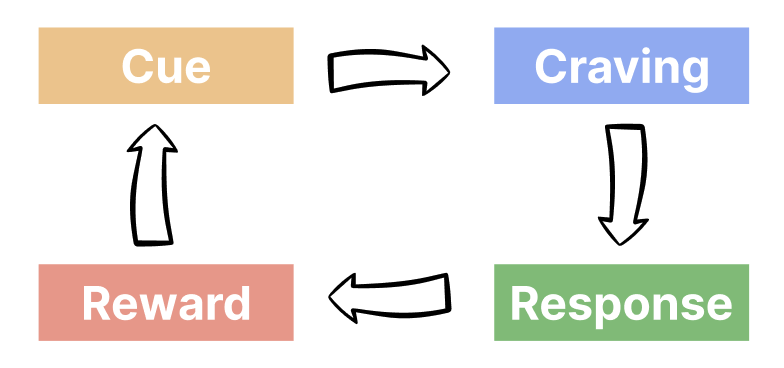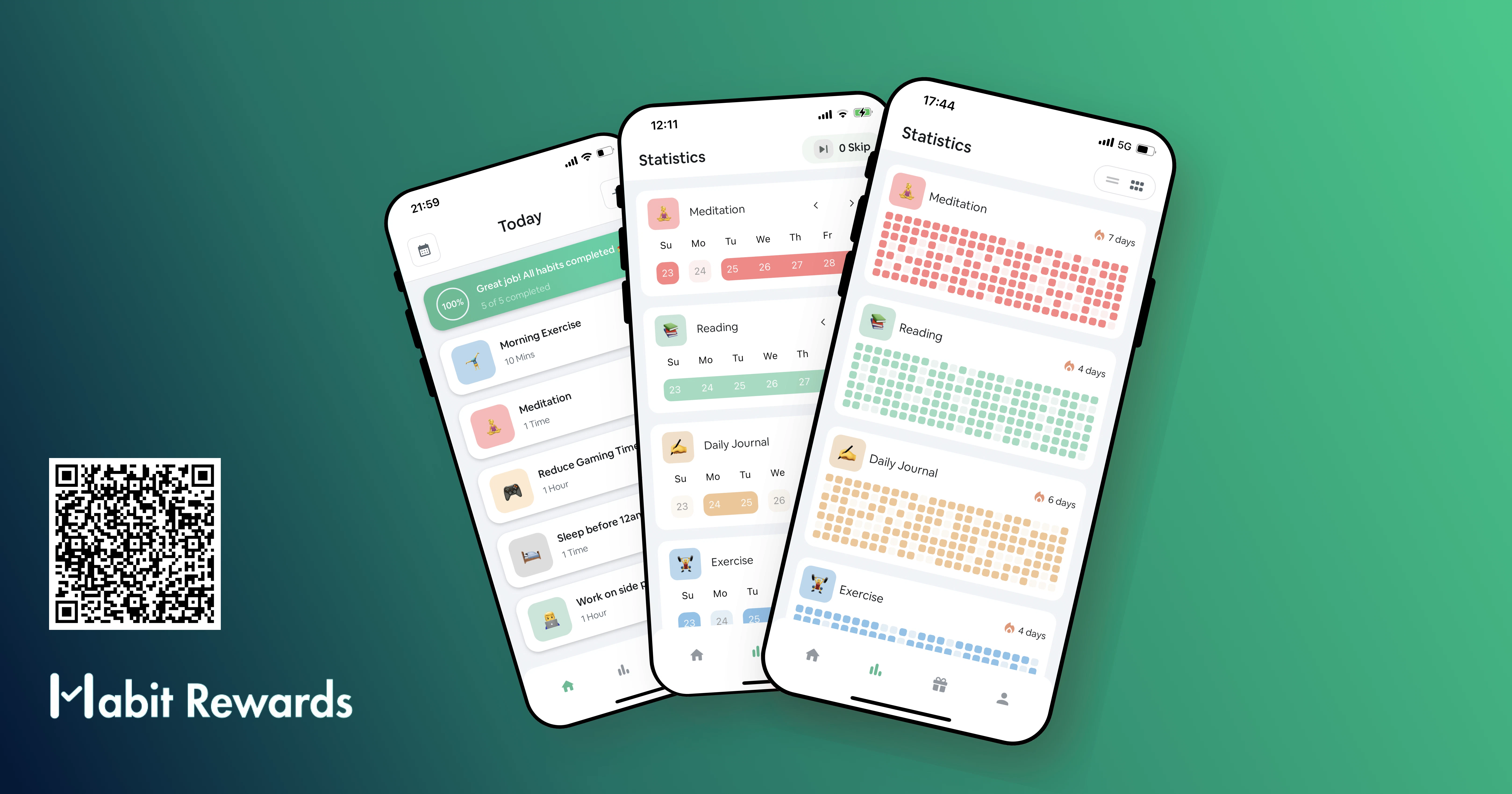Introduction
Ever wondered why some habits stick while others fade away?
The secret lies in the power of rewards. By using Habit Rewards, you can turn the process of building good habits into a fun and engaging journey. This article will reveal why rewards are essential for building habits and how you can leverage the habit loop – Cue, Routine, Reward – to your advantage. Dive in to discover how you can transform your daily routines and build better habits with the right habit rewards.
Understanding the Habit Loop
What is the Habit Loop?
The habit loop, a popular concept proposed by Charles Duhigg in The Power of Habit, consists of three main components: the cue, the routine, and the rewards.

Cue: The Triggers for The Habit Loop
The cue is the trigger that initiates the behavior. It can be an external stimulus, like seeing a snack on the counter, or an internal one, like feeling stressed.
For example, the sound of your alarm in the morning might cue you to start your day.
To be more specific, we can categorize the cues of habit loop as follows:
- Time-based (e.g., waking up)
- Location-based (e.g., entering the gym)
- Emotional states (e.g., feeling stressed)
- Preceding actions (e.g., finishing a meal)
- Social situations (e.g., being with friends)
Identifying and leveraging these cues is the first step in understanding the habit loop and sets the foundation of the habit rewards process.

Routine: The Behavior of The Habit Loop
The routine is the actual behavior you perform in response to the cue. This can be anything from reading a page of a book to going for a run. Routines can be simple actions or complex sequences of behaviors.
Routine is the habit itself. It’s the action that you’re trying to change or reinforce.
It is triggered by the cues, and reinforced by the rewards.
Reward: The Reinforcement of The Habit Loop
The reward is the benefit you gain from the behavior, reinforcing the habit loop. Rewards can be immediate, like the satisfaction of a good workout, or delayed, like the health benefits of regular exercise. The anticipation of the reward drives the repetition of the routine.
Effective habit rewards can:
- Boost motivation
- Create positive associations
- Increase dopamine release
- Enhance long-term habit adherence
Understanding how to reward yourself for good habits is crucial for sustained behavior change.
Rewards are crucial in reinforcing habits. They provide the positive reinforcement needed to repeat the behavior. Rewards can be intrinsic (internal satisfaction) or extrinsic (external incentives).
Intrinsic Rewards are internal benefits, like a sense of accomplishment or personal satisfaction. These rewards are powerful because they come from within and often have a lasting impact on motivation.
Extrinsic Rewards are external benefits that serve as powerful motivators for habit formation. These rewards can include money, treats, gifts, or recognition from others. For example, you might reward yourself with a healthy snack after completing a workout, or a trip to place you want to travel after hitting a milestone.
Extrinsic rewards are particularly effective because they provide tangible incentives that can make the process of building habits more enjoyable and engaging.

Habit Rewards App is a nice habit tracker with rewards to help your achieve your goals. Scan QR code or click on the image to download from the App Store.
Habit Rewards App is a habit tracker that allows your to set and customize these extrinsic rewards to match your personal preferences and goals.
How to Implement The Habit Loop Effectively
To make the habit loop work for you, it’s essential to understand how to identify your cues, establish beneficial habits, and choose the right habit rewards.
Identifying Your Cues: Start by recognizing the triggers that prompt your habits. Keep a journal to note down when and where you feel the urge to perform a particular behavior.
Establishing Beneficial Habits: Focus on building habits that align with your goals. Make sure they are specific, achievable, and enjoyable.
Choosing the Right Rewards: Select rewards that are meaningful and motivating to you. They should provide immediate gratification or longer-term motivation to reinforce the habit positively.
Next, let’s look at some practical rewards you can set for your habits.
Practical Rewards for Your Habits
Implementing rewards effectively is essential for maintaining motivation and ensuring the success of habit formation. By choosing the right type of rewards and scaling them appropriately with your achievements, you can create a sustainable and enjoyable habit-building process. Let’s explore different types of rewards and how to utilize them effectively.
Immediate Rewards for Habits: Accelerating Habit Formation
Immediate rewards for habits are particularly powerful in reinforcing behavior. They create a direct link between the action and the positive feeling, strengthening the habit loop. Examples of immediate rewards include:
- Enjoying a healthy snack after a workout
- Taking a short walk outside after completing a work task
- Spending a few minutes on a hobby after finishing a chore
- A favorite song or short video
- A quick stretching session
- Checking off an item on a to-do list
By incorporating these immediate rewards, you can strengthen your habit loop and accelerate the process of building habits.

Scale Your Reward with Your Accomplishments
To ensure your habit rewards remain effective and motivating, it’s crucial to match the scale of the reward with the significance of the accomplishment. This approach not only sustains your motivation but also acknowledges the effort and progress you’ve made. Here are some strategies to help you align your rewards with your achievements:
Incremental Rewards
Start with smaller, more frequent rewards for initial milestones and gradually increase the value of the rewards as you achieve larger goals.
For instance, if your goal is to lose 50 pounds, reward yourself with something small and enjoyable, like a new workout outfit, after losing the first five pounds.
As you progress and hit more significant milestones, increase the reward’s value. For example, after reaching the halfway mark, treat yourself to a weekend getaway, and for achieving your ultimate goal, consider a more substantial reward like a trip to Cabo.
Point Accumulation System
Implement a point system where you accumulate points based on your efforts and accomplishments, which can then be redeemed for rewards.
For example, you could earn one point for every minute of exercise. Once you accumulate 150 points, reward yourself with a manicure. At 300 points, you could get a pedicure. Accumulating 500 points could earn you a massage, and reaching 1000 points might reward you with a full spa day. This system not only provides immediate rewards but also encourages consistency and long-term commitment by offering more substantial rewards for sustained effort.
Habit Rewards App allows you to customize rewards with varying levels of difficulty, using systems like point accumulation. Download it now to start tracking your habits, unlock rewards you desire, and achieve your goals.
By scaling your rewards to match your accomplishments, you create a balanced and motivating reward system that keeps you engaged and driven to continue building and sustaining positive habits. This approach not only helps in achieving your goals but also ensures that the rewards feel meaningful and well-deserved, making the entire journey more satisfying and enjoyable.
The Science Behind Habit Loop
For those interested in the scientific aspects of habit loop, this section delves deeper into the mechanisms behind habit formation of habit loop.
Neuroplasticity and Habit Loop: Habits are formed through neuroplasticity - the brain’s ability to create and strengthen neural connections. Each time you repeat a behavior, the associated neural pathway becomes stronger, making the habit more automatic over time.
The Connection Between Habits and Memory: Habits are closely linked to memory. When you perform a habit, your brain uses a stored pattern of neural activity, or “memory trace,” to guide the habit. Consistent repetition strengthens these memory traces, making the habit more ingrained.
Overcoming Challenges in Building Habits
Building habits can be challenging, and setbacks are a normal part of the process. However, with the right strategies, you can navigate these challenges and stay on track towards your goals. Here are some effective approaches:
Dealing with Setbacks
Setbacks are normal. When they occur, take the opportunity to reassess your cues, goals, rewards and make adjustments to ensure they continue to motivate you.
- Acknowledge Setbacks: Recognize that setbacks are not failures but opportunities to learn and grow. Instead of getting discouraged, analyze what caused the setback and how you can prevent it from happening again.
- Reassess Your Approach: Take a step back and evaluate your current strategy. Are your goals realistic? Are your rewards motivating enough? Sometimes, a minor tweak in your plan can make a significant difference.
- Modify Your Rewards: Ensure your rewards are still aligned with your goals and are sufficiently motivating. If you’ve lost motivation, it might be time to introduce new rewards that excite you more.
- Celebrate Small Wins: Even if you’ve faced a setback, celebrate the progress you’ve made so far. Recognizing small achievements can boost your morale and motivate you to keep going.
- Stay Positive and Persistent: Maintain a positive outlook and remind yourself why you started the habit in the first place. Persistence is key, and overcoming setbacks with a resilient attitude will help you build stronger habits over time.
Adjusting Rewards
If a reward loses its effectiveness, switch it up. Find new and exciting ways to reward yourself to keep the habit formation process engaging.
Here’s how you can keep your rewards fresh and motivating:
- Identify Reward Preferences: Take note of what types of rewards you find most motivating. Do you prefer tangible items, experiences, or personal achievements? Tailor your rewards to your preferences to keep them exciting.
- Rotate Rewards: Avoid monotony by rotating your rewards. If you’ve been rewarding yourself with the same treat repeatedly, try switching it up. For example, if you’ve been treating yourself to a favorite snack after completing a task, switch to a different reward like a short break to read a chapter of your favorite book.
- Introduce New Rewards: Introduce new and exciting rewards to keep the habit formation process engaging. This could include trying out new activities, exploring new places, or buying something you’ve had your eye on. The novelty will keep you motivated.
The Habit Loop in Atomic Habits: Cue, Craving, Response, Reward

The Atomic Habits from James Clear introduces a new version of the habit loop, adding ‘craving’ and ‘response’ to the habit loop. Understanding this can further enhance your habit-building strategy.
The four-step pattern includes cue, craving, response, and reward:
- Cue: The event that triggers the habit, also known as a reminder
- Craving: The desire for a particular outcome or state
- Response: The action or thought that is taken
- Reward: What the behavior does for the person
The ‘response’ basically corresponds to the ‘routine’ step in the original habit loop. The craving is a mental motivational force to do the habit. Anyway, in both habit loops, the habit rewards play an important role.
In this habit loop from Atomic Habits, the ‘response’ corresponds to the ‘routine’ step, representing the actual behavior or action triggered by the cue. The ‘craving’ serves as a mental drive or motivation that precedes the ‘response,’ compelling the individual to perform the habit.
Both habit loops emphasize the role of habit rewards as essential components. Rewards reinforce the habit loop by providing positive reinforcement. This reinforcement strengthens the habit loop, making the behavior more sustainable over time.
Conclusion
Mastering the Cue, Routine, Reward habit loop is a game-changer in personal development. By understanding the power of habit rewards and implementing effective strategies, you can transform your life one habit at a time. Remember, consistency is key, and with the right rewards system in place, you’ll be well on your way to achieving your goals and becoming the best version of yourself.
Start your journey today by identifying a habit you want to build, choosing appropriate cues, and planning your rewards. With dedication and the right approach to habit rewards, you’ll be amazed at what you can achieve!
✅ Try Habit Rewards App
A simple habit tracker app that helps you build better habits, achieve your goals
- Neat design with beautiful grids
- Visualize your progress at one glance
- Set reminders for your habits
- Customize rewards you desire for your achievements
- Set flexible habits and frequency
- Start now for free

Habit Rewards App is a simple habit tracker with rewards to help your achieve your goals.
Scan the QR code to download from the App Store.
Using Notion?
Build better habits and achieve your goals with this nice Notion Habit Tracker template.
More articles your may be interested in:
